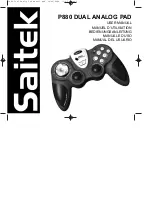
Crestron
DM-RMC-SCALER-S/S2
DigitalMedia 8G Fiber Receiver
Operations & Installation Guide – DOC. 7324B
DigitalMedia 8G Fiber Receiver: DM-RMC-SCALER-S/S2
3
Multimedia Display Interface
A single HDMI digital AV output port is provided on the DM receiver, supporting
HD 1080p60 video and WUXGA computer signals with HDCP, Deep Color, 3D
1
,
and multichannel HD lossless audio—all through one connection. The HDMI output
can also handle DVI signals using an appropriate adapter or interface cable.
2
A single fiber strand connects the DM receiver to a DM switcher or transmitter (each
sold separately), transporting video, audio, control, and networking signals through
one SC type (DM-RMC-SCALER-S)/LC type (DM-RMC-SCALER-S2) optical
connection.
3
Multiple DM receivers may be installed to handle each display in a
multiroom distribution system, all fed from a central DM switcher (sold separately).
Or, a single DM receiver can be fed straight from a DM fiber transmitter (DM 8G
transmitter sold separately for the DM-RMC-SCALER-S or DM 8G SM transmitter
sold separately for the DM-RMC-SCALER-S2) to extend a computer or AV signal
to a single display.
High-Definition Scaler
Through a distributed scaler approach, DigitalMedia delivers a flexible and
user-friendly solution for routing multiple disparate sources to many different
display devices. By placing an independent high-performance scaler at every display
device, DM ensures an optimal image on every screen regardless of the sources that
are selected. Distributed scaling allows a high-resolution computer source to be
viewed on any display in the building. It also allows a high-definition 3D source to
be viewed on lower resolution 2D displays without compromising the original signal.
The DM receiver accepts any video source from standard NTSC 480i to HD
1080p60 with Deep Color, as well as computer sources from VGA to
UXGA/WUXGA, and scales them perfectly to match the native resolution of the
video display. A range of common output resolutions is supported to work with
virtually any popular flat panel display, projector, or computer monitor. Intelligent
frame rate conversion enables support for 24p and PAL format sources, and 3D to
2D conversion allows 3D content to be fed simultaneously to separate 3D and 2D
displays. Setup and use of the scaler is simplified through fully automatic operation
utilizing the display’s EDID.
1, 4
A pair of DM receivers can also be used to facilitate a dual-projector 3D setup,
steering the left eye portion of a 3D signal to one projector and the right eye portion
to the other. This is done using the scaler’s 3D to 2D conversion mode, enabling 3D
capability with scaling.
1. Automatically passes 3D video if display device supports it (reverts to pass-through mode
without scaling). Provides automatic 3D to 2D conversion (with scaling) if display device does not
support 3D.
2.
HDMI requires an appropriate adapter or interface cable to accommodate a DVI signal.
CBL-HD-DVI interface cable sold separately.
3.
For DM 8G wiring, the maximum DigitalMedia 8G fiber cable length is 1000 feet (~300 meters)
using CRESFIBER8G fiber optic cable, or 500 feet (~150 meters) using standard CRESFIBER,
CRESFIBER-SINGLE-SC, or generic OM3 simplex multimode fiber optic cable. For DM 8G SMF
wiring up to 7.5 miles (12 km) between devices, use Crestron CRESFIBER8G-SM or generic
G.652.D (or better) single-mode fiber optic cable. Refer to the latest version of the Crestron
DigitalMedia Design Guide (Doc. 4546) for complete system design guidelines. All wire and cables
sold separately.
4.
EDID (Extended Display Identification Data) is data embedded in an HDMI, DVI, or VGA signal that
enables a display device to tell the source device what resolutions and formats it can support, allowing
the source to configure itself automatically to feed the best signal that both devices can support.










































